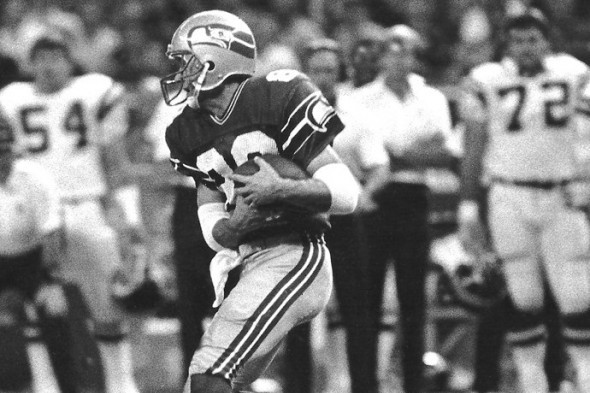
By David Eskenazi and Steve Rudman
Never in four decades (well, nearly four) has a regular-season Seahawks game stirred local masses quite as much this year’s Week 2 showdown with the San Francisco 49ers at CenturyLink Field. It has to do with soaring expectations. Several pundits have picked the Seahawks to reach – and win — the Super Bowl, with the caveat that only the 49ers in the NFC, who lost to Baltimore in February, are standing in their way.
In its NFL predictions piece last week, Sports Illustrated asked seven of its writers to opine on the “Game I’m Looking Forward To Most.” Four picked Sunday night’s matchup at The Clink. Two voted for the Seattle-San Francisco rematch in Week 14. The only other game mentioned: Denver at Indianapolis in Week 7, because Peyton Manning returns to face his former team for the first time.
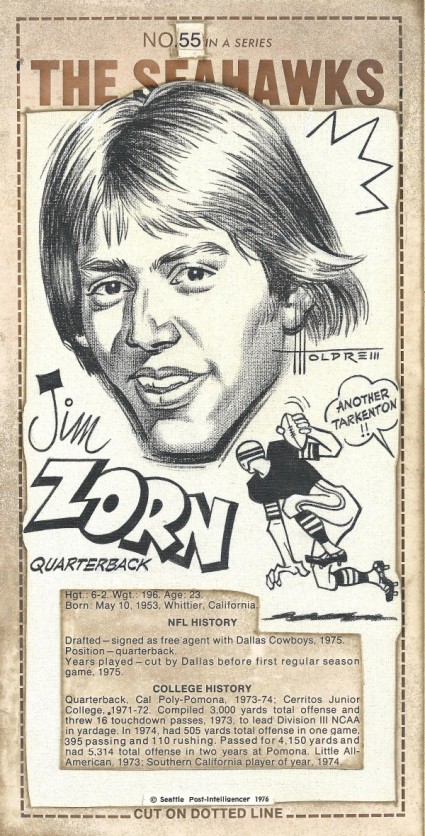
ESPN selected Seattle vs. San Francisco to showcase in its Sunday night time slot months ago, and the Seahawks usually acquit themselves well on the national stage. They are 18-8 on Monday Night and 19-18 in games played on Thursday-Sunday nights.
Thirty-four years ago, the Seahawks had a raucous debut on prime time when they traveled to Atlanta to appear on Monday Night Football for the first time. MNF was then in its Giff, Howard and Dandy Don heyday and the Seahawks in just their third NFL season. The game that unfolded that night featured a repertoire of fake field goals, fake punts, onside kicks and gutsy fourth-down calls in what became an instant classic and still ranks high on the list of all-time thigh slappers to those who witnessed it.
————————————–
When Seattle sports consumers opened their daily newspapers on the morning of Monday, Oct. 29, 1979 (the Dow stood at 823.81), they were greeted with four above-the-fold stories, the most prominent of which detailed a knee operation performed on University of Washington senior running back Joe Steele at University Hospital. For Steele’s fans, the news was grim: “Steele’s UW Football Career Over,” blared The Seattle Post-Intelligencer’s headline.
The most proficient Husky runner since Hugh McElhenny, Steele suffered what the P-I described as a “devastating” injury two days earlier in the third quarter of Washington’s 34-14 win over UCLA at Husky Stadium, and it was severe enough, according to a University Hospital spokesperson, that Steele’s NFL prospects had also been severely compromised.
The second story recounted a 108-97 victory by the SuperSonics over the Chicago Bulls at the Seattle Center Coliseum (Gus Williams 26 points), the third speculated on a probable trade of popular Mariners center fielder Ruppert Jones to the New York Yankees, and the fourth disclosed that the Seattle Sounders of the North American Soccer League were involved in negotiations to hire Alan Hinton of the Tulsa Roughnecks as their new head coach.
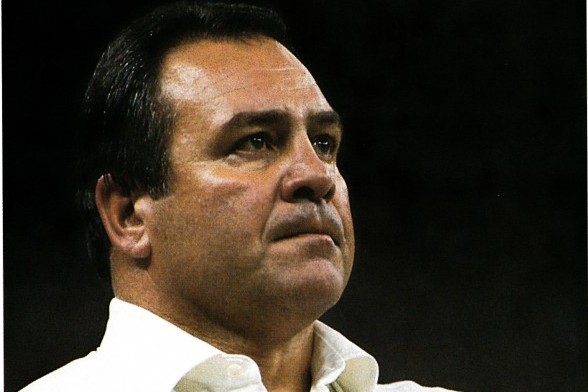
The main entertainment scheduled for that Monday, the Seahawks’ Week 9 game at Atlanta, came next in the editorial pecking order, with emphasis on the novelty of it: The fourth-year Seahawks had never, with one minor exception, played in front of a national television audience, nor had they played a contest with a scheduled kickoff at 9 p.m., local time.
“This is the big time now,” Seahawks wide receiver Steve Raible told reporters from both newspapers. “But we can’t let it detract from our concentration. The biggest problem is adapting to the time. First. there’s playing on Monday, and then there’s the 9 p.m. start, which is an unusual time to play football. It screws up your schedule. But I’m looking forward to it. There’s an opportunity for us to win two in a row.”
While Seattle would be making its debut in prime time, it appeared on national TV one other occasion, Nov. 26, 1978, when the fourth quarter of a game in Oakland went nationwide. That turned out to be a memorable day for the early Seahawks: placekicker Efren Herrera, he of the distinctive waddle, drilled a 46-yard field goal with three seconds remaining, giving Seattle a 17-16 victory over the hometown Raiders, and enabling the Seahawks to become the first team since 1965 to beat Oakland twice in the same season.
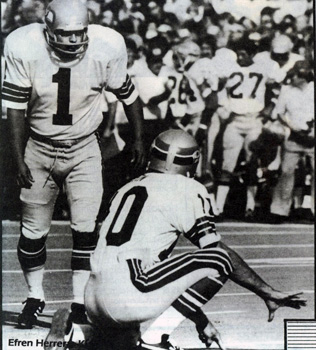
The Seahawks won two of three following the Oakland squeaker to close out 1978 with a 9-7 record, but 1979 was off to a rough start. Although the Seahawks were coming off a big win over the Oilers, they dropped five of their first eight. The Falcons also reeled at 3-5. Both teams had yielded 181 points.
“Seattle will be the biggest test for our defense that we’ll face all year,” Atlanta coach Leeman Bennett said during a mid-week conference call with reporters. “They’ve got an explosive offensive team with (quarterback) Jim Zorn having the ability to run, throw and throw on the run. Their running backs may not have breakaway speed, but they can do some damage. Sherman Smith and Dan Doornink pick their holes well. We need to play well. We need some good news.”
Atlanta needed some good news. The city had just been identified as the homicide capital of the nation, the 200th murder of the year occurring hours before the Seahawks and Falcons kicked off at Fulton County Stadium, where a sellout crowd of 60,743 was expected. But rain had left the recycled baseball lot of the Atlanta Braves slippery underfoot and irrigated a blossoming of umbrellas among the 52,566 who finally showed.
Despite the matching 3-5 records, oddsmakers installed Atlanta as a six-point favorite, apparently swayed by the Falcons’ home-field edge, the throwing ability of Steve Bartkowski, the fifth-year quarterback out of California, the 1-2 punch of rookie running backs William Andrews and Lynn Cain, and the speed of receivers Wallace Francis and Alfred Jenkins.

Howard Cosell seemed to agree with Atlanta as the favorite, noting for the ABC audience that in nine years of Monday Night Football home teams won 60 percent of the time.
But Cosell foil Dandy Don Meredith observed that the Seahawks had their own advantage: Every one of their opponents took them too lightly.
Although Dandy Don would prove prescient, the Seahawks did not start well, in fact appearing lethargic as Cain, a first-round draft pick out of Southern California who blocked for Heisman Trophy winner Charles White, burst 35-yards for a first-quarter touchdown, providing the Falcons a 7-0 lead.
Forty-three seconds after Cain’s romp, a Seahawks drive stalled at their 49-yard line. Herman “Thunderfoot” Weaver punted, but Tom Pridemore blocked his boot. Rick Byas recovered and frolicked 30 yards for a touchdown and a 14-0 Atlanta lead. The Falcons, it appeared, were on the verge of blowing out the Seahawks.
“Atlanta was just sky-high, really up, and we were just the opposite, flat,” Seahawks DE Bill Gregory complained. “We didn’t play good at all at the beginning. I thought we were over that.”
Neither Gregory nor anyone else could have foreseen the developments of the next 14 minutes.
Starting from their 30-yard line following a 31-yard return by Tony Green, Zorn scrambled for a 12-yard gain, found Steve Largent for 16 and Doornink for three more, but faced a fourth-and-five from the Atlanta 34. Instead of ordering Weaver to punt, Seahawks coach Jack Patera ordered the first of four bamboozle plays, a quarterback draw. Zorn executed it flawlessly, running untouched 34 yards to slice Atlanta’s lead to 14-7.
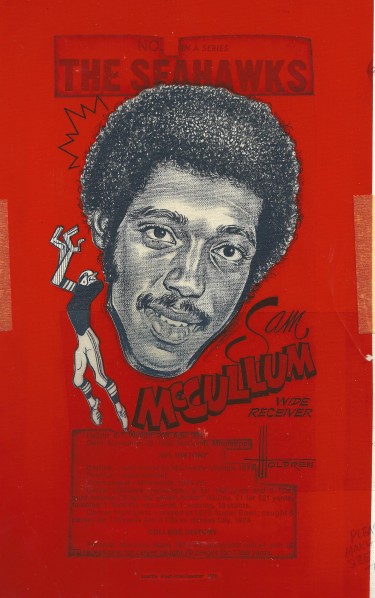
Seattle defensive tackle Robert (Heartburn) Hardy added to the momentum when he sacked Bartkowski. Seattle corners Dave Brown and Cornell Webster then successfully defensed Bartkowski long balls to Jenkins and Francis, forcing to Atlanta to punt.
It took Zorn seven plays to get Seattle back in the end zone with a four-yard pass to Sherman Smith. At Herrera’s sideline suggestion, Patera opted for an off-the-wall, an on-side kick the Falcons in no way expected.
“I noticed that their ends were dropping off fast and I told Jack I thought it would work,” Herrera said.
Kicker and coach had a mutual respect for each other, Herrera holding no grudge against Patera for having said, following one of Efren’s field goal misses, that Herrera “must have eaten a bad enchilada.”
“Jack said to me, ‘You’ve got the option, but make it work.’”
The onside kick, of course, was in Herrera’s repertoire, but never did he execute it with more flair. SS Keith Simpson recovered at the Atlanta 42-yard line.
Zorn went to Largent three times on the ensuing drive, but completed only one of the throws for five yards. Patera dispatched Herrera to attempt – or so everyone thought — a 55-yard field goal. The Falcons should have known something was up. Herrera’s previous longest was 52 yards, for Dallas against Washington Oct. 17, 1977.
Before the Falcons could figure out what was going on, suddenly there was Herrera, a droll sight running down the field, his stubby limbs trying to stay ahead of his oil-drum torso, and catching a football that he was supposed to have been kicking for a field goal.
Herrera’s reception and subsequent eight-yard waddle after catch resulted in a 20-yard gain to the Atlanta 17 and sparked a cascade of amazements from the ABC broadcast booth.

“We worked on that play in practice last week,” Herrera admitted. “But I had never caught a pass in a game before, either in college or as a professional.”
Asked why he called Herrera’s number, Patera quipped, “We were on national television. Why save it for just a regional audience?”
It took three plays following Herrera’s improbable catch for Seattle to take a 21-14 led, Doornink going in from eight yards.
Another Hardy sack of Bartkowski blunted Atlanta’s first drive of the third quarter, and Zorn capitalized immediately, finding Largent for a 53-yard gain to the Falcons’ 10-yard line. The Seahawks could go no further and Patera took the safe route, ordering a field goal. Herrera’s 27-yarder gave the Seahawks a 24-14 lead.
Patera took another gamble in the third quarter, calling for Weaver to pass out of punt formation.
“It is hard to believe that Jack Patera, the taciturn coach, would countenance, or even consider, a forward pass by Herman Weaver off a fake punt with 12 yards to go for a first down from his own 32 yard line,” The Seattle Times opined. “Brilliantly executed, the pass to Jessie Green, his first-ever catch as a Seahawk, was complete, but fell two yards short of the first down. That was the only time that the Hawks, for the entertainment of the masses, shot the works on fourth down, and the only failure.”
Although upstaged on their own turf, the Falcons refused to fold. Two series after Weaver’s pass failed to pick up a first down, Bartkowski tossed a 17-yard touchdown to Billy Ryckman, a backup receiver in nobody’s fantasy league.
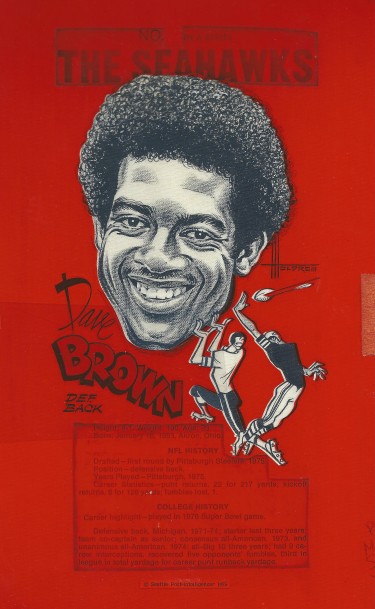
Zorn fumbled away Seattle’s next possession — after Doornink had kept the drive alive by gaining 19 yards on another fourth-down gamble — but back-to-back sacks by Gregory and Manu Tuiasosopo and a short Falcon punt set up the Seahawks at the Atlanta 34. Doornink, who ran for a career-high 127 yards, carried four straight times, finishing the drive with a 26-yard touchdown and a 31-21 Seattle lead with two minutes remaining.
The Seahawks commenced a sideline celebration, premature as it turned out.
“After that touchdown,” Patera disclosed, “Zorn came to the sidelines and said, ‘It feels awfully good to win.’ I told him, ‘Please don’t say that.’”
Zorn nearly choked on his words as Bartkowski completed five consecutive passes, the last a 20-yard touchdown to Ryckman, that brought the Falcons to within 31-28 with a minute to play. Worse, Atlanta kicker Tim Mazzetti then pulled a Herrera with a successful onside kick recovered by Pridemore at the Falcons’ 45.
An old-fashioned defensive play saved the day for the Seahawks. With 33 seconds remaining, Atlanta had a first down at the Seattle three. The prospect of a Falcon win, or at the very least an overtime game, loomed as Bartkowski lofted as pass in the end zone intended for Russ Nikeska, a tight end being covered by linebacker Keith Butler.
Brown was covering Ryckman, who had caught two touchdowns. But Brown read the play perfectly, left his man and arrived in Nikeska’s vicinity just in time to make a leaping interception, his second of the night.
“They killed us with their special teams,” said Atlanta safety Frank Reed, four years out of the University of Washington. “It’s a big disappointment and hard to explain.”
“I’m happy we won, but after being around the league a while I guess you strive more for perfection,” Gregory said. “To have the Falcons come back to within three points was ridiculous. After overtaking them the way we did we should have won going away.”

Though all — from Patera to Zorn – denied it, the Seahawks obviously had been saving an array of oddball stunts to introduce to the national audience. The tactic succeeded and, thanks largely to Cosell, who spent a good portion of the broadcast singing Seahawks praises, TV viewers, especially in the east, went to bed with the impression the Seahawks were the most unpredictable team in the NFL.
The Seahawks proved the point – perversely – six days later. Back in the Kingdome to face the Los Angeles Rams, the Seahawks had it handed to them in one of the worst beatdowns in franchise history.
The final score – Rams 24, Seahawks 0 – became inconsequential compared to the most ghastly statistic in club annals: a minus seven yards total offense, which remains the NFL record 34 seasons later.
The Seahawks lost an average of 7.2 inches on each play, made only one first down, didn’t reach Rams territory until the middle of the third quarter, and never had the ball for more than 1:58 on any of their 12 possessions.
“We did a helluva job,” said Rams’ DE Fred Dryer. “I’m sure when we look at the film we’ll find someone who made a mistake, but who cares?”
After playing one of the most exciting games in franchise history one week and the most dreadful the next, the 1979 Seahawks closed out their season by winning five of six to finish 9-7.
——————————————-
Many of the historic images published on Sportspress Northwest are provided by resident Northwest sports history aficionado David Eskenazi. Check out David’s Wayback Machine Archive. David can be reached at (206) 441-1900, or at seattlesportshistory@gmail.com

3 Comments
Sunday Night Football is on NBC, not ESPN.
Not to nit pick, but 1979 was their 4th season as 1976 was their first.
Boy, talk about firing up the DeLorean and revisting old favorites. I recognized every name in here. Too bad Steve Raible didn’t play a bigger part in this game. Great to see Fred Dryer mentioned as well since he might be recognzied more as an actor today. This was such a fun game to watch when it happened.